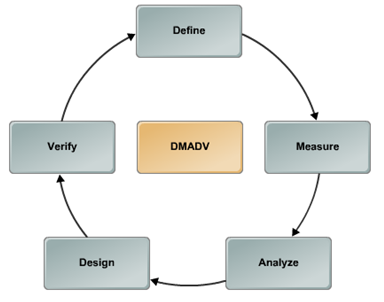Another roadmap of DFSS is DMADV, an acronym for five interconnected phases, namely Define, Measure, Analyze, Design, and Verify. This methodology is used in projects that involve creating a new product or process design.
Define – The project goals are defined so that they are in line with customer requirements and enterprise strategies.
Measure – Characteristics that are critical to quality as well as product and process capabilities are measured.
Analyze – The different process options are analyzed and the best process that is consistent with customer requirements is selected.
Design – The details of the process are designed and optimized to meet the needs of customers followed by the performance of the new design which is tested through pilot runs before implementation.
Verify – In this phase the results are test and implementation of new design is carried out for large scale deployment.
Tags
Measure Phase of Lean Six Sigma Project is the second phase. Following are the deliverable of this phase:
- Identify all possible causes (Cause & Effect Diagram)
- Validate Measurement System, Data Collection & Sampling
- Establish Process Capability
Identify all possible Causes (Cause & Effect)
In the measure phase of a Lean Six Sigma Project, the team brainstorms to identify all possible causes or reasons for the occurrence of the problem. Thus, there is a direct linkage between a project charter and this deliverable. Fish-bone diagram is a structured brainstorming method used to carry out this activity. Fish-bone diagram is also called as Ishikawa or Cause & Effect diagram. After completing this brainstorming, the team applies the 5-why technique to further explore the underlying causes for all the reasons identified in the fish-bone diagram. At the end of these two activities, the team has an exhaustive list of possible causes for the problem. Usually there are around 50~100 possible causes for the problem. It is the responsibility of Six Sigma Green Belt to facilitate these activities.
As a next step, using their process knowledge and experience, the team has to agree on few causes; which potentially cause the problem. There are several methods to do this, but the most popular method is the use of Cause & Effect Matrix (C-E Matrix). Potential Causes are suspects that are causing the problem. However, before acting on them, the team needs to gather data or facts to validate them.
Validate Measurement System, Data Collection & Sampling
Data Collection plays a very important role in all Six Sigma projects. But before collecting data, the team has to assess if the measurement system (measuring instrument, appraiser & environment in which measurement happens) is accurate and precise. Hence the team has to perform Measurement System Analysis (MSA) – aka Gage R&R. Once the team ascertains that the measurement is good, then a data collection plan is prepared. Data Collection Plan (DCP) includes the measures whose data needs to be collected, how much data to collect, data source, and who will collect the data, etc. While the entire team can participate in this activity, Six Sigma Green Belt has to take a lead role, as this will involve technical concepts of Gage R&R covered in the training program.
Unlike conventional data collection; in Lean Six Sigma projects, data is collected on both the CTQ and the potential causes identified in a Cause & Effect Matrix. Due to the quantum of data involved in most businesses, it isn’t practically viable to collect data of the entire population. Hence the team has to resort to statistical sampling methods.
As a next step, data collection is executed. From time-to-time a Six Sigma project team needs to validate the data collected. Sometimes, the data collectors need to be trained and retrained. Once the data collection is complete, it is ready for a process capability assessment. Usually many projects get delayed because of poor data quality or delay in collecting sufficient data. When a Six Sigma Green Belt takes special care, this activity can get completed on time.
Establish Process Capability
Process Capability is the ability of the process to deliver as per customer requirement. There are various process capability indices, but in Lean Six Sigma projects, sigma capability is the most popular measure. This exercise gives an accurate report on the current process performance. As these indices are covered in the training program, Six Sigma Green Belt has to take a lead role in conducting this study. The output of Process Capability study can be used to validate the process objectives and anticipated benefits in the charter. If needed, the Lean Six Sigma project charter can be revisited.
On completion of the above deliverable, and a formal Measure Phase tollgate review, the team is ready to move into Analyze phase. Next>>>
Tags
Measure Phase of Lean Six Sigma Project is the second phase. Following are the deliverable of this phase:
- Identify all possible causes (Cause & Effect Diagram)
- Validate Measurement System, Data Collection & Sampling
- Establish Process Capability
Identify all possible Causes (Cause & Effect)
In the measure phase of a Lean Six Sigma Project, the team brainstorms to identify all possible causes or reasons for the occurrence of the problem. Thus, there is a direct linkage between a project charter and this deliverable. Fish-bone diagram is a structured brainstorming method used to carry out this activity. Fish-bone diagram is also called as Ishikawa or Cause & Effect diagram. After completing this brainstorming, the team applies the 5-why technique to further explore the underlying causes for all the reasons identified in the fish-bone diagram. At the end of these two activities, the team has an exhaustive list of possible causes for the problem. Usually there are around 50~100 possible causes for the problem. It is the responsibility of Six Sigma Green Belt to facilitate these activities.
As a next step, using their process knowledge and experience, the team has to agree on few causes; which potentially cause the problem. There are several methods to do this, but the most popular method is the use of Cause & Effect Matrix (C-E Matrix). Potential Causes are suspects that are causing the problem. However, before acting on them, the team needs to gather data or facts to validate them.
Validate Measurement System, Data Collection & Sampling
Data Collection plays a very important role in all Six Sigma projects. But before collecting data, the team has to assess if the measurement system (measuring instrument, appraiser & environment in which measurement happens) is accurate and precise. Hence the team has to perform Measurement System Analysis (MSA) – aka Gage R&R. Once the team ascertains that the measurement is good, then a data collection plan is prepared. Data Collection Plan (DCP) includes the measures whose data needs to be collected, how much data to collect, data source, and who will collect the data, etc. While the entire team can participate in this activity, Six Sigma Green Belt has to take a lead role, as this will involve technical concepts of Gage R&R covered in the training program.
Unlike conventional data collection; in Lean Six Sigma projects, data is collected on both the CTQ and the potential causes identified in a Cause & Effect Matrix. Due to the quantum of data involved in most businesses, it isn’t practically viable to collect data of the entire population. Hence the team has to resort to statistical sampling methods.
As a next step, data collection is executed. From time-to-time a Six Sigma project team needs to validate the data collected. Sometimes, the data collectors need to be trained and retrained. Once the data collection is complete, it is ready for a process capability assessment. Usually many projects get delayed because of poor data quality or delay in collecting sufficient data. When a Six Sigma Green Belt takes special care, this activity can get completed on time.
Establish Process Capability
Process Capability is the ability of the process to deliver as per customer requirement. There are various process capability indices, but in Lean Six Sigma projects, sigma capability is the most popular measure. This exercise gives an accurate report on the current process performance. As these indices are covered in the training program, Six Sigma Green Belt has to take a lead role in conducting this study. The output of Process Capability study can be used to validate the process objectives and anticipated benefits in the charter. If needed, the Lean Six Sigma project charter can be revisited.
On completion of the above deliverable, and a formal Measure Phase tollgate review, the team is ready to move into Analyze phase. Next>>>
Design for Six Sigma (DFSS) is an approach that is part of the Six Sigma methodology, and it aims to develop products and services which operate at Six Sigma or above. What does this mean; and how is this approach different from implementing six sigma in existing products, services & processes? If you have read our articles What is Six in Six Sigma, and What is Sigma in Six Sigma; you will understand how Six Sigma is measured.
Every process performs at its designed and operating capability. For instance, consider the Indian traffic and transportation management system. A good measure of its performance is the number of deaths due to road accidents. There are several other measures, but for simplicity let’s just consider this one. This performance measure is called CTQ (Critical To Quality).
India has the largest number of deaths per year due to road accidents (Approximately 130,000 deaths per annum). If we were to commence a Six Sigma project to reduce the number of deaths, we would use DMAIC approach. We will identify root causes for this problem, and try to eliminate them with good and sustainable solutions. For instance, helmets and seat belts mandatory, enforcement of speed limits & drunken driving laws, additional traffic patrols, etc., may be few solutions we will implement.
By doing so, lets hypothetically assume that we have been able to reduce the number of deaths to 30,000 per annum, in 3 years’ time. However, we aren’t able to reduce it any further. This stage; when any process or system is delivering its best performance, is referred to as Process Entitlement.
However, 30,000 is still a high number and we want to bring it down to manageable double digits. So we have to discard our existing traffic & transport management system; and design a completely new system, from scratch, that will help us reach our target. Double digit fatality means we will operate well within Six Sigma level, considering our 1.2 billion population as a base.
Such a process of re-designing or newly designing any product, service or products is referred to as DFSS. Design for Six Sigma is defined as a Customer focused design approach used for creating products, services, and processes which will deliver Six Sigma Performance. Samsung products are a very good example of Design for Six Sigma.
In many fields like airline, surgery, automobile braking, etc., require processes to deliver Six Sigma at all times. For such systems, design for six sigma concept comes handy. The very first time products and processes are developed, they are designed to deliver Six Sigma performance.
Following are the key differentiators for DFSS:
- Understand customer requirements, and translate them to product performance measures.
- Design products, sub-systems, and processes to deliver Six Sigma performance.
- Design ‘first time right’ products and services.
- Innovative designs deliver Six Sigma performance, rather than existing designs.
- Optimize the design for usability, manufacturability, or serviceability.
While DFSS is a principle, there are different ways in which it can be put to use. IDOV and DMADV are popular approaches.
IDOV is a 4 step approach representing Identify, Design, Optimize & Verify. And DMADV is a 5 step approach representing Define, Measure, Analyze, Design & Verify.






